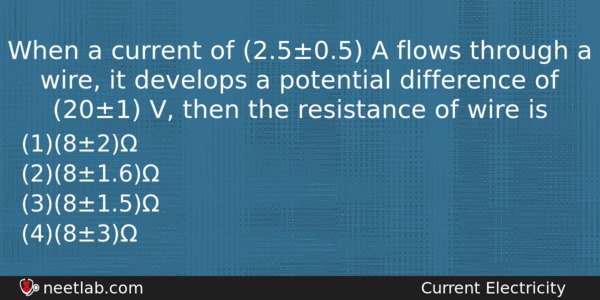| ⇦ | 
| ⇨ |
When a current of (2.5±0.5) A flows through a wire, it develops a potential difference of (20±1) V, then the resistance of wire is
Options
(a) (8±2)Ω
(b) (8±1.6)Ω
(c) (8±1.5)Ω
(d) (8±3)Ω
Correct Answer:
(8±2)Ω
Explanation:
No explanation available. Be the first to write the explanation for this question by commenting below.
Related Questions: - In a parallel plate capacitor of capacitance C, a metal sheet is inserted
- What is the difference between soft and hard X-ray?
- The velocity v of waves produced in water depends on their wavelength λ, the density
- If a wire is stretched to four times its length, then the specific resistance
- An electron moving in a circular orbit of radius r makes n rotations per second.
Topics: Current Electricity
(136)
Subject: Physics
(2479)
Important MCQs Based on Medical Entrance Examinations To Improve Your NEET Score
- In a parallel plate capacitor of capacitance C, a metal sheet is inserted
- What is the difference between soft and hard X-ray?
- The velocity v of waves produced in water depends on their wavelength λ, the density
- If a wire is stretched to four times its length, then the specific resistance
- An electron moving in a circular orbit of radius r makes n rotations per second.
Topics: Current Electricity (136)
Subject: Physics (2479)
Important MCQs Based on Medical Entrance Examinations To Improve Your NEET Score
18000+ students are using NEETLab to improve their score. What about you?
Solve Previous Year MCQs, Mock Tests, Topicwise Practice Tests, Identify Weak Topics, Formula Flash cards and much more is available in NEETLab Android App to improve your NEET score.
Share this page with your friends

R=V/I
R=20/2.5
R= 8 ohm
Now,
∆ R/R=∆ V/V+∆I/I
=1/20 +0.5/2.5
= 1/4
Therefore,
∆ R÷R=1÷4
∆ R=1÷4×R
∆R=1÷4×8
∆R=2
Therefore,
Resistance with error limits=R+ – ∆R
=(8+ – 2)ohm